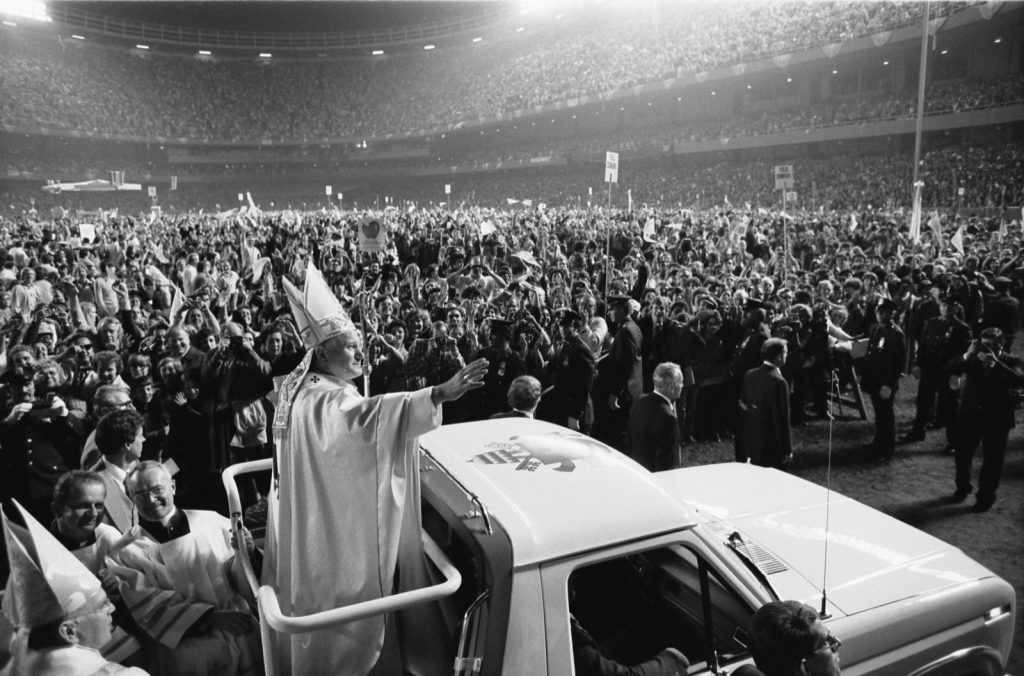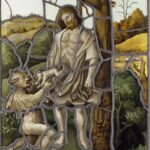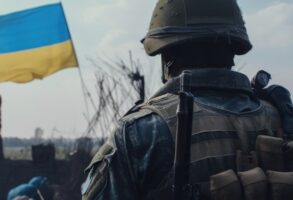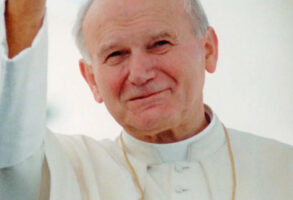
Published May 1, 2015
This article is adapted from the fourteenth annual William E. Simon Lecture, delivered on February 4, 2015.
When the Catholic Church celebrated the canonizations of Pope John Paul II and Pope John XXIII on April 27, 2014, the Church was not “making saints,” and neither was Pope Francis. Rather, the Church and the pope were recognizing two saints that God had made, publicly declaring its conviction that, in these two men of our time, the grace conferred in baptism had borne fruit in a heroic exercise of the theological virtues of faith, hope, and love, and the cardinal virtues of prudence, justice, courage, and moderation. In canonizing John Paul II, then, the Catholic Church was not recommending the Polish pope as an exemplar of shrewd and effective statecraft, as scholars and political leaders might lift up George C. Marshall or Dean Acheson as models of statesmanship. Still, John Paul II’s heroic exercise of the chief virtue of statecraft—prudence—contains important lessons for those practicing the arts of governance on a global stage in the twenty-first century.
St. John Paul II always insisted, correctly, that he was neither diplomat nor politician. He was, rather, a pastor, who in exercising his pastoral responsibilities had things to say to the world of political power, because those things had to do with the Church’s defense of human dignity, the protection of which gives the exercise of public authority a distinctive excellence and a fundamental moral purpose. Yet this Polish-born pastor who refused to don the mantle of politician or diplomat, choosing instead the role of moral witness, was the most politically consequential pope in centuries, a pope whose evangelically inspired action changed history and left a deep impression on the future. The footprints of his distinctive statecraft can be found all over the world: in central and Eastern Europe, which he helped liberate from communism; in Latin America, Asia, and Africa, where men and women formed by John Paul II’s social doctrine are striving to make freedom for excellence work in the political and economic fields; in the United States, Canada, and western Europe, where John Paul II’s robust defense of religious freedom as the first of human rights has taken on new, and perhaps unexpected, salience in postmodern societies threatened by what Benedict XVI called the “dictatorship of relativism.”
To be sure, the responsibilities of a pope and the responsibilities of presidents, prime ministers, members of legislatures, diplomats, and other public officials are not identical. Popes no longer deploy hard power in the form of armies, as they once did; democratic leaders charged with the defense of the common good must calculate the interests of the people they represent and serve in ways that popes don’t. Which is to say that popes and public officials deal with international politics out of different toolkits. Still, in this season in which statecraft is often misunderstood as a form of psychotherapy, things seem to be coming unhinged, and the West is unsure of itself and its role as the guarantor of a measure of decency and order in world affairs, it’s useful to reflect on what we can learn from the distinctive global statecraft of a saint who had a real impact on what the pundits are pleased to call the “real world.”
The First Lesson:
Culture drives history.
John Paul II’s statecraft rejected the fallacies that made political modernity a slaughterhouse. He rejected the Jacobin fallacy, born in 1789, that history is driven by politics, understood as the quest for power, understood as my ability to impose my will on you. He rejected the Marxist fallacy that “history” is merely the exhaust fumes of the means of production. And he rejected the liberal fallacy that if a society only gets the machinery of democracy and the free economy right, those machines can run by themselves. Rather, drawing on both Catholic and Polish sources, John Paul II insisted that culture was, is, and always will be the most dynamic force in history, allowing us to resist tyranny and inspiring us to build and sustain free societies. Moreover, he understood that at the center of culture is cult, or religion: what people believe, cherish, and worship; what people are willing to stake their lives, and their children’s lives, on.
This culture-first approach to history and statecraft was on full display during John Paul’s first papal pilgrimage to Poland: nine days in June 1979 on which the history of the twentieth century pivoted. The Nine Days are often described as a moment of national catharsis, and there is undoubtedly something to that: The pent-up frustrations, sorrows, and angers engendered by Poland’s awful experiences over two centuries—its vivisection in the late nineteenth century, its demolition by Nazis, and its desecration by communists—began to be healed by the triumphant return to his homeland of Poland’s papal son. But a lot more was happening in Poland in June 1979 than catharsis. The papal visit empowered a transformation: the revitalization of culture in a revolution of conscience.
The Nine Days of John Paul II in June 1979 were, arguably, the most politically potent papal intervention in world affairs since the High Middle Ages. Yet the pope didn’t mention politics or economics once.Rather, John Paul spoke the truth about Poland’s history, its culture, and its national self-understanding, saying, in dozens of variations on one great theme, “You are not who they say you are. Remember who you really are, own the truth of your history and your culture, and you will find tools of resistance that totalitarianism cannot match.” By returning to his people the truth about themselves, the pope gave Poles the raw materials with which to forge tools of liberation that were essentially moral and cultural in nature. Deployed over a hard decade of struggle that led to the triumphs of the Revolution of 1989, those tools proved more than adequate in answering Stalin’s cynical question, “The pope? How many divisions does he have?”
The Second Lesson:
Ideas count, for good and for ill.
I doubt that John Paul II ever read John Maynard Keynes. But he certainly understood the truth of what the Cambridge economist meant when he wrote that ideas, “both when they are right and when they are wrong, are more powerful than is commonly understood. Indeed the world is ruled by little else. Practical men, who believe themselves to be quite exempt from any intellectual influences, are usually the slaves of some defunct economist. Madmen in authority, who hear voices in the air, are distilling their frenzy from some academic scribbler of a few years back. . . . Soon or late, it is ideas . . . which are dangerous for good or evil.”
The dangers of false ideas John Paul knew from experience. Living in what Timothy Snyder has aptly dubbed the “bloodlands” of East Central Europe, he had seen the lethal effects of Lenin’s, Stalin’s, and Hitler’s wicked ideas in the deaths of tens of millions of human beings, including his friends and classmates. But he also knew from experience the regenerative power of noble ideas: for example, the ideas of Christian Democracy deployed by men like Konrad Adenauer, Alcide de Gasperi, and Robert Schuman in rebuilding postwar Europe and laying the foundations of today’s European Union. In both cases—the wicked, false, and death-dealing ideas, and the good, true, and ennobling ideas—what was most crucial, in John Paul II’s view, was the idea of the human person being proposed. Or to use a social science term in its philosophical sense, what counted was anthropology.
And here we find the connection between Karol Wojtyła, Polish philosopher, and John Paul II, statesman. In the first decade of his pontificate, John Paul II, statesman, saw that the Yalta division of Europe was not only wrong but fragile and unsustainable, because Karol Wojtyła, Polish philosopher, knew that Stalin’s power-grab in the waning days of the Second World War was in service to a false idea of the human person, a warped anthropology that led inevitably to the Gulag, the KGB, the Berlin Wall, and the rest of the apparatus of Soviet repression. In the last years of his papacy, John Paul II, statesman, knew that twenty-first-century Europe risked dissolving into incoherence because Karol Wojtyła, Polish philosopher, had accurately measured the deficiencies of the atheistic humanism and soul-withering secularism that were at the root of Europe’s post–Cold War crisis of civilizational morale.
Thus, practitioners of statecraft who wish to learn from the example of John Paul II will take ideas, and the war of ideas, with as much seriousness as indices of gross national product or measures of military capability. Why? Because all three are connected. Neither wealth nor military power can be usefully deployed in the cause of freedom if the will to do so is not present. And it seems unlikely that the West will form such a will—the will to challenge the lies and propaganda of the forces of disorder as a precondition to restoring a measure of order to world affairs—if our culture continues to be eroded from within by skepticism and relativism, by an anthropology that reduces the human person to a mere bundle of desires, and by a nihilism that mocks all religious and moral conviction.
The Third Lesson:
Don’t psychologize the adversary.
One result of the decline of political philosophy and the concurrent rise of social science in the late-modern and postmodern West has been the emergence of psychological approaches to statecraft. In America one can trace this back to the social science theories popular among the “best and brightest” of the Kennedy/Johnson years: the mandarins who believed that a naval blockade of Cuba in 1962 was a form of “communication” and who imagined that “signaling” North Vietnam by turning the spigot of air power on and off could change Ho Chi Minh’s behavior. The Obama-era analogue to this psychologization of statecraft is the famous “reset,” first with Russia and the Arab Islamic world, most recently with Cuba, perhaps this year or next with Iran. The premise here is that bad guys behave badly because of what we do, so that if we behave differently, their behavior will change and become less disagreeable, if not downright praiseworthy.
John Paul II knew this for the foolishness it was and is. As a keen student of the human condition, he understood that bad guys behave badly because of who they are, what they espouse, and what they seek, not because of anything “we” did to “them.” Thus he could focus on the issues at hand—religious freedom and other basic human rights in the communist world, for example—without tying himself up in knots over whether the Cold War division of Europe was somehow Harry Truman’s fault. Unlike Western revisionist historians, John Paul understood that Stalin, his heirs, and their Polish epigones did what they did because of who they were and what they sought, not because good old Uncle Joe had been offended by the haberdasher from Independence, Missouri, at the Potsdam Conference in July 1945.
The twenty-first-century lessons to be drawn should be obvious. To take one urgent case: Vladimir Putin is doing what he’s doing in Ukraine, Moldova, the Baltic states, and elsewhere not because of anything Ukraine, Moldova, or other post-Soviet states did to him or to Russia, but because of who he is, what he believes, and what he seeks. Thus accounts of the current war in Ukraine that seek to “balance” responsibilities for the conflict (or, worse, describe it as a “civil war”) distort reality and in doing so make creative and sensible policy virtually impossible. The same is true of the clerical totalitarians who hold ultimate authority in Tehran. Unless their behavior in seeking a nuclear capability is understood on its own terms as an expression of their apocalyptic ideas and ambitions rather than as a reaction to pressures from the Sunni world, the West, or both, the world will remain vulnerable to Iranian dissembling and stalling, and the likelihood of an Iranian bomb will grow accordingly.
The Fourth Lesson:
Speak loudly and be supple in deploying whatever sticks, large or small, you have at hand.
When John Paul II was elected the 264th Bishop of Rome on October 16, 1978, Vatican diplomacy was well into the second decade of its Ostpolitik, an approach to the problems of local Catholic Churches behind the Iron Curtain that avoided public condemnation of communism’s human rights violations for the sake of reaching diplomatic agreements with Warsaw Pact countries. Those agreements were supposed to guarantee the Church’s freedom to live its sacramental life by its own standards. In the event, however, what limited agreements were achieved demoralized the resistance Church in several East bloc countries, turned the Catholic Church in Hungary into a subsidiary of the Hungarian party-state, did nothing to relieve the condition of Catholics in the Soviet Union, and opened the Vatican to further penetration by communist intelligence services, a process that had begun in the early 1960s.
Yet John Paul was shrewd enough not to dismantle the Ostpolitik of Pope Paul VI and his principal diplomat, Archbishop Agostino Casaroli. Rather, he made Casaroli his own Secretary of State, named him a cardinal, and gave him free rein to pursue his diplomacy east of the Elbe River. Thus no communist leader could publicly accuse the Church of reneging on its previous commitments because of a “reactionary” Polish pope in league with NATO. (Of course, Soviet and Eastern bloc propaganda and disinformation campaigns worked overtime to sell precisely that message throughout the West, not without some success.) But while Casaroli continued his bilateral diplomatic efforts, John Paul II restored the Catholic Church’s voice, challenging human rights violations and calling upon communist states to honor their human rights commitments under “Basket Three” of the 1975 Helsinki Final Act—and did so by making his own voice the Vatican’s principal voice. Time and again, in venue after venue, John Paul II lifted up the first freedom, religious freedom, and brought his case before the world in his 1979 address to the U.N. General Assembly. And because of that papal megaphone (and its amplification by Radio Free Europe and Radio Liberty), the resistance Church behind the Iron Curtain knew it had a champion; those in the West who were committed to supporting the resistance Church in central and Eastern Europe were inspired to expand their efforts; and all the while, the Soviet rationale for the Cold War was being systematically undercut in the order of ideas.
The Polish pope applied the same methods to shore up Catholic leaders working for justice and peace in Central America in the face of Marxist governments and insurgencies there. The Sandinista tide began to recede when John Paul II vocally confronted the adolescent cheerleading of Daniel Ortega and his comrades at a 1983 papal Mass in Managua. (Thanks to some adroit work by papal trip-planner Roberto Tucci, the entire affair, including the pope demanding “Silencio!” from Ortega & Co. so that he could preach his sermon, was telecast throughout the region.) Yet John Paul was also willing to be the quiet persuader, working behind the scenes while local churchmen did the denouncing of injustice, when that seemed appropriate. This method worked well in Argentina, Chile, and the Philippines, where the pope met with (and thus endorsed and gave protection to) local human rights activists and political reformers while he worked privately on the Argentine military, on General Augusto Pinochet, and on President Ferdinand Marcos, urging them to respect human rights and restore democracy in their countries.
The lesson for the twenty-first-century statesman: Moral pressure can be an important lever in world politics, but effective human rights advocacy and democracy-promotion require dexterity—diplomatic dexterity, and dexterity in waging the battle of ideas.
The Fifth Lesson:
Listen to the martyrs.
The Ostpolitik that dominated Vatican diplomacy for the fifteen years prior to the election of John Paul II did not dishonor the persecuted local Churches behind the Iron Curtain. But it did tend to regard their intransigence as an obstacle to diplomatic accommodations between the Holy See and communist regimes. And such accommodations had to be reached, according to the Ostpolitik, because the Yalta division of Europe was a permanent reality of world politics, not a temporary aberration. Thus in the decade prior to John Paul’s election, Paul VI removed Cardinals Josef Beran and József Mindszenty from their posts in Prague and Budapest and kept the exiled leader of the Greek Catholic Church in Soviet-occupied Ukraine, Cardinal Josyf Slipyj, at a distance.
John Paul II had long viewed the witness of the martyr-confessors in the underground Churches behind the Iron Curtain differently. To his mind, the witness of these brave men and women, living and dead, helped strengthen a religiously informed cultural resistance to communism because it uniquely embodied the moral pressure that could and should be exerted on communist regimes. So during his time as archbishop of Krakow, Wojtyła clandestinely ordained priests for service in the underground Church in Czechoslovakia, in what amounted to a tacit challenge to the Vatican’s Ostpolitik. As pope, he made sure that the world (and especially the Kremlin) knew of his meeting with the Ukrainian Cardinal Slipyj, leader of the largest underground Church in the world, a month after his election. That meeting took place a few weeks after he had sent his cardinal’s zucchetto to the Ostrabrama shrine at Vilnius in Lithuania as a gesture of solidarity with another long-suffering and bitterly persecuted local Church, a gesture that was repaid within weeks as the Lithuanian Committee for the Defense of Believers’ Rights was formed and became one of the most dogged human rights proponents in the Soviet Union.
This pattern continued throughout the pontificate and was not limited to the pope’s support for fellow Catholics. John Paul II deployed his own private contacts into the USSR to keep himself informed of the views of the hard-pressed human rights resistance there. One result: his December 1985 meeting in the Vatican with Elena Bonner, wife of Andrei Sakharov, which was arranged by one of John Paul’s informal agents, Irina Ilovayskaya Alberti, former aide to Aleksandr Solzhenitsyn in his Vermont exile.
For John Paul II, the witness of the modern martyr-confessors deserved honor and respect in its own right. Just as the Church demeaned itself, he believed, when it accommodated the demands of totalitarian persecutors, so the Church was strengthened by acknowledging the witness of its sons and daughters who had taken the risk of freedom and paid the price for it. Honoring the persecuted Church also had an important effect on the Holy See’s diplomatic action in world politics, acting as a brake against the realpolitik pragmatism that, while common in European foreign ministries, is neither realistic nor pragmatic over the long haul.
There are lessons here for dealing with such twenty-first-century challenges as the transition to a post-communist future in Cuba and China, and in responding to the lethal threats posed by jihadist Islam to Christian communities in the Middle East and Africa. Listening to the voices of the martyr-confessors of these regions will clarify the true nature of the challenges posed by the Cuban and Chinese regimes and by jihadists, thus erecting another barrier against the psychologization of conflict. Lifting up the witness of the living martyr-confessors publicly and persistently might also afford them a measure of protection, while helping sustain islands of civil society essential to future progress toward justice and peace in Cuba, China, the Middle East, and Africa.
The Sixth Lesson:
Think long-term and do not sacrifice core principles to what seems immediate advantage.
In the mid-1980s, after martial law had been lifted in Poland but while the independent self-governing trade union Solidarity was still legally banned, officials of General Wojciech Jaruzelski’s communist regime sounded out Polish church leaders with a proposal: The regime would open a national dialogue on Poland’s future and the Church would act as the regime’s interlocutor. Some Polish churchmen were tempted by the offer. But John Paul II declined the bait. Solidarity was the proper representative of Polish civil society, in his view, and the Church ought not substitute itself in that role, especially when that meant tacitly acquiescing to Solidarity’s legal non-status. The Church could help facilitate a conversation between the regime and the opposition, but the Church ought not replace the opposition.
That decision had theological roots. In John Paul II’s ecclesiology, the Church could not be a partisan political actor because that role contradicted the Eucharistic character of the Church (a theme he stressed in his challenge to various forms of Latin American liberation theology). It also reflected the strategic vision of John Paul II’s social doctrine, in which the Church formed the people who formed the civil society and the political institutions that did the work of politics; the Church was not a political agent in its own right, although the Church obviously had a voice in society.
In the event, the Church’s refusal to play “opposition party” to the “leading role” of the Communist party in Poland increased the pressure on the Jaruzelski regime to recognize the real Polish opposition, which was represented by Solidarity. Thus John Paul II’s principled decision helped create the conditions for the possibility of the Polish Round Table of early 1989 and the partially free elections of June 1989. And those elections, by delivering an overwhelming victory to Solidarity, made possible the first non-communist government in postwar Polish history.
The lesson here, for both twenty-first-century statesmen and the diplomats of the Holy See, would seem to be this: The cause of freedom and the cause of the Church are best served when statesmen and churchmen acting as statesmen think long-term and do not bracket or minimize core principles for what can seem to be immediate advantage. That lesson bears on the Church’s role in Cuba today, where local church leaders’ understandable desire to strengthen the Church’s institutional infrastructure should go hand in hand with a vigorous defense of the dissidents who form the core of the Cuban civil society of the future. A two-pronged strategy of building while resisting is most likely to midwife a post-Castro future while preparing the ground for the task of reconverting Cuba after its liberation.
This sixth lesson also suggests cautions about the current push for full diplomatic relations between the Holy See and the People’s Republic of China. In the present circumstances, any such deal would require the Vatican to sever its diplomatic exchange with the Republic of China on Taiwan—the first Chinese democracy in history. What signal would such a deal, with such a price tag, send about the Catholic Church’s vision of China’s future? What signal would it send about the Church’s concern for the hard-pressed and often persecuted elements of civil society that exist in China today and are pressing for a non-authoritarian and open future? The evangelical mission of the Church in the mainland China of the future is not going to be materially advanced by accommodating too easily the current regime.
There are also lessons here for the Holy See’s role in Ukraine. The Vatican’s longstanding preoccupation with maintaining cordial ecumenical relations and serious theological dialogue with the Russian Orthodox Church should be reassessed in light of the fact that in the Ukrainian drama that has been unfolding since November 2013, the current Russian Orthodox leadership has functioned as an agent of Russian state power, playing its own sorry role in Kremlin propaganda and disinformation campaigns. Neither common ecumenical witness in defense of international legal norms nor serious theological dialogue is possible under these circumstances. Pretending otherwise merely reinforces the damage being done by aggressors and their clerical allies.
The Seventh Lesson:
Media “reality” isn’t necessarily reality.
The most unintentionally hilarious commentary on the public impact of Pope John Paul II came from—surprise!—the editorial page of the New York Times. John Paul was in the middle of those epic nine days of June 1979 when, on June 5, the Times ran an editorial on the papal pilgrimage with this conclusion: “As much as the visit of Pope John Paul II to Poland must reinvigorate and reinspire the Roman Catholic Church in Poland, it does not threaten the political order of the nation or of Eastern Europe.”
Well, not quite.
Why did the Times so badly miss the reality of what was afoot in Poland? In part, I suspect, because it regarded “the Roman Catholic Church in Poland” as of no more political consequence to “the political order of the nation or of Eastern Europe” than the Polish Flat-Earth Society (which, come to think of it, is not a bad analogue for the Times’s general view of the Catholic Church). Then there was the view in the liberal world (for which the Times was both mirror and infallible teaching authority) that the Cold War would be resolved when an increasingly social democratic West “converged” with a liberalizing East and the Berlin Wall would simply dissolve: a “narrative” popular in certain European (and indeed Vatican) circles. And then there was the Times’s concern, shared by many foreign policy “realists” in the West, that any disturbance of the Yalta postwar order threatened nuclear holocaust. So, while it might be too bad for what were once called the “captive nations,” the way things were was the way things were going to have to be, lest greater demons be set loose.
These narratives—the narrative of the political irrelevance of religion in the late twentieth century; the narrative of “convergence”; and the change-risks-nuclear-war narrative—seemed to be reality. But they weren’t reality. John Paul II was wise enough to know that and to act according to what was really reality: that a morally informed human rights resistance, based on a clear and correct conception of the dignity of the human person, attacked communism at its most vulnerable point and thus held one of the keys to settling the Cold War in favor of the forces of freedom.
The problem of confusing reality with “media reality” or narrative has intensified since 1979, in no small part because of the ubiquity of social media and instant Internet commentary, both of which readily create narratives that seem to be reality. Yet the statesmen of the twenty-first century would do well to take a lesson from John Paul II and read the “signs of the times” with their own eyes, rather than through lenses befogged by media-generated narratives. The same lesson applies to churchmen. Church leaders, clerical and lay, who respond to media-generated narratives about the Catholic Church rather than to the imperatives of the Gospel are not going to advance either the evangelical mission of the Church or the cause of human dignity and freedom. The Gospel has power, and its power can cut through the densest of false narratives.
The dramatic life of John Paul II displayed many admirable qualities worth emulating. But at this historical moment, his refusal to submit to the tyranny of the possible is the most compelling and inspiring characteristic of the man.
The great hopes that followed the Revolution of 1989, the collapse of the Soviet Union, the various color-revolutions in the post-communist world, and most recently the Arab Spring, have often been frustrated. “History” is manifestly not over, and the forces that stand for ordered liberty in the world seem to be in retreat. Too much of Latin America has reverted to chronic patterns of corruption and authoritarianism, or corruption and incompetence, or corruption, incompetence, and authoritarianism. Incapable of putting its fiscal house in order, responding forcefully to the threats posed by a revanchist Russia, or dealing with home-brewed jihadist terrorism and anti-Semitism, Europe remains paralyzed by a crisis of civilizational morale that only the willfully ignorant or fanatically secular will fail to recognize as spiritual in character. That religious freedom has come under assault in the West within two decades of its vindication in the formerly communist world was not something that many expected in 1989—or at the turn of the millennium, for that matter. What Pope Francis has aptly described as a “throwaway culture,” in which the disposable are not just consumer goods but people, is eroding the moral-cultural fabric of our civilization. Drastically different ideas of the human person, human community, and human destiny are in conflict throughout the Western world, and have much to do with the alleged gridlock of American domestic politics.
At such a moment—our moment—it is imperative to learn from John Paul II and refuse to be bound by self-imposed shackles of low expectations, submitting to the tyranny of the possible as the conventional wisdom of the day defines the possible. Had Karol Wojtyła, on becoming John Paul II, accepted the conventional wisdom of the moment, he would have settled down to manage the inevitable decline of the Catholic Church in a world permanently divided along geopolitical and ideological fault lines defined in the late 1940s. Because he believed more deeply, and thus saw more clearly, he discerned sources of renewal in the Church where others saw only decay, and he saw openings for freedom where others saw only impenetrable walls. By refusing to accept the tyranny of the possible, he helped make what seemed impossible not only possible but real.
Events proved that his signature challenge on October 22, 1978—“Be not afraid!”—was not romanticism. It was the deepest, truest realism. Or as he put it to thousands of young people in Krakow in June 1979, as they gathered near the site of the martyrdom of St. Stanislaus, “Be afraid only of thoughtlessness and pusillanimity.”
The West would do well to heed that summons and that challenge today.
George Weigel is Distinguished Senior Fellow of Washington’s Ethics and Public Policy Center, where he holds the William E. Simon Chair in Catholic Studies.








